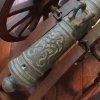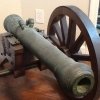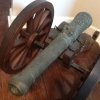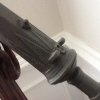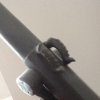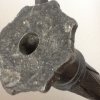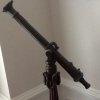I haven't had much experience of pirates, although I have known a few cowboys in my time. I'm not going to ask if anyone can identify this wood fuze, it could even be homemade. What is interesting is the writing on the side which says 'taken from the BORNEO PIRATES'! If anyone does know where Borneo pirates obtained their fuzes, then it would be interesting to know. Perhaps they aquired them from other vessels!
British Ordnance Collectors Network
You are using an out of date browser. It may not display this or other websites correctly.
You should upgrade or use an alternative browser.
You should upgrade or use an alternative browser.
wood 'pirate' fuze
- Thread starter Rrickoshae
- Start date
yes, ideally with 'taken from the Borneo Pirates' written on it!
Can you post pictures of the ends? I used to trade in Dutch VOC bronze cannons and Lantaka, many recovered from Borneo, Brunei, Malasia.Very cool fuse! Now you need the cannon ball!
I would say according cannon bore size, it would be for large bore cannons. Keeping in mind large bore cannons were not manufactured until vertical drilling of bores was adapted in the mid 1750's ( prior the bores were sand cast, bore size was limited). My guess by the length of your fuze would indicate it is for an 18 or 24 pounder ( bore about 5.17", and 5.68"), a common naval size. Age? No idea but powder charged wooden fuzes were used mid 1750's thru the 1860's and fairly easy to construct. Lots of info about the Dutch VOC and Malay pirates on the web. A few pictures for interest: a late 1600's early 1700's rail gun ( land salvage- pristine, deep honey brown patina ) about 1" sand cast bore, manufactured by the Dutch. Second Dutch, well used bore and vent, sand cast 1.5" bore w/unknown crest late 1600's, brackish water/ mud salvage, both unearthed from a 30 meter by 30 meter VOC trading outpost. Aquired from a modern day " pirate" (long story- he is still probably in jail )near Sarawak before Heritage laws went into effect. I regret selling off my VOC cannon collection 20 years ago.see the attached 917601, its 4 & 7/8s inches long if that helps. There are 4 pin holes at the top which presumably held a protecting cap over the quickmatch. Dave
Attachments
Last edited:
Keeping in mind large bore cannons were not manufactured until vertical drilling of bores was adapted in the mid 1750's ( prior the bores were sand cast, bore size was limited)..
The mediaeval Europeans and Ottomans might disagree with that. They built large calibre siege bombards on the hoop and bar method, as for example Mons Meg from 1449:
https://en.wikipedia.org/wiki/Mons_Meg
The hoop and bar method of making early guns actually gave the name "barrel" to the tube.






